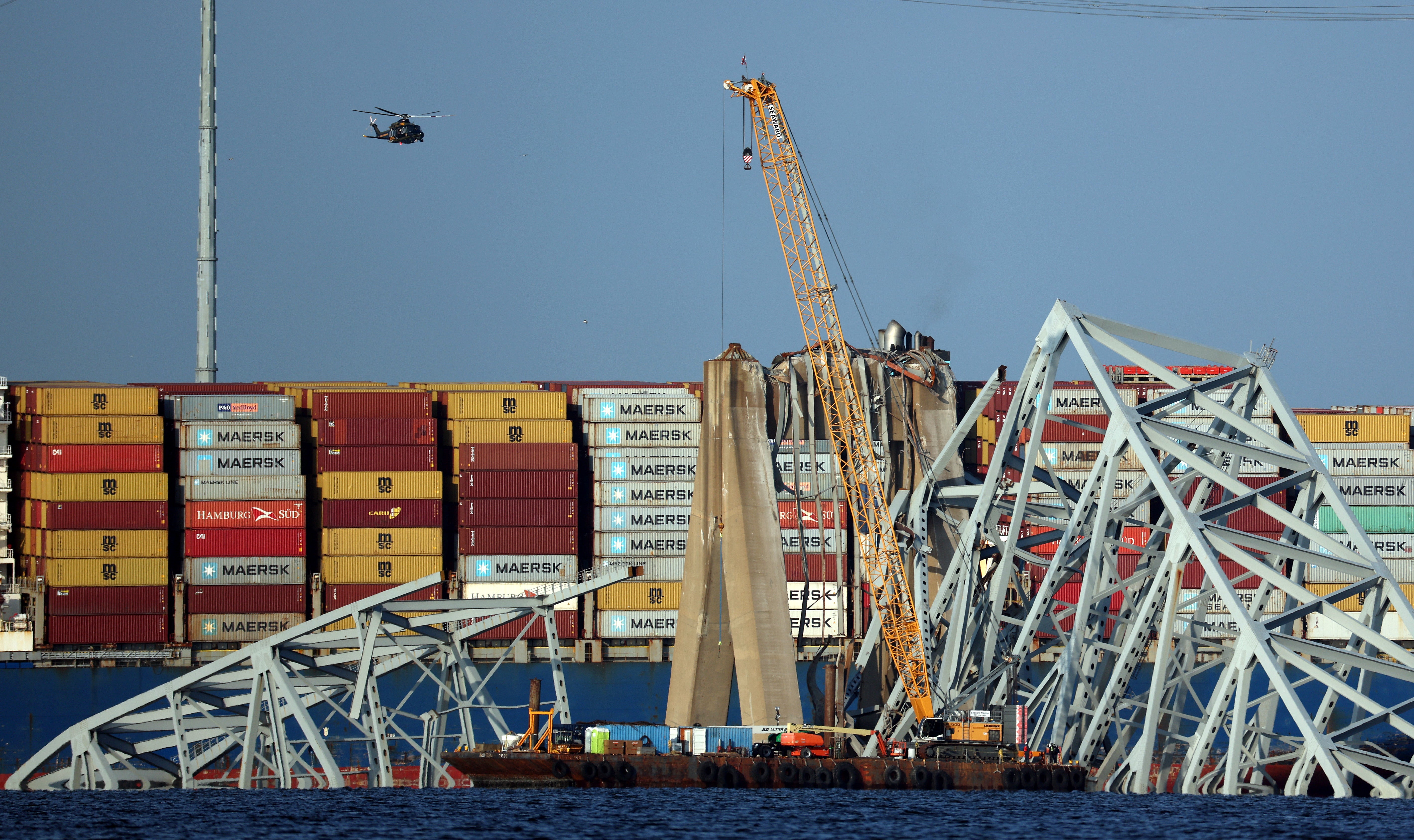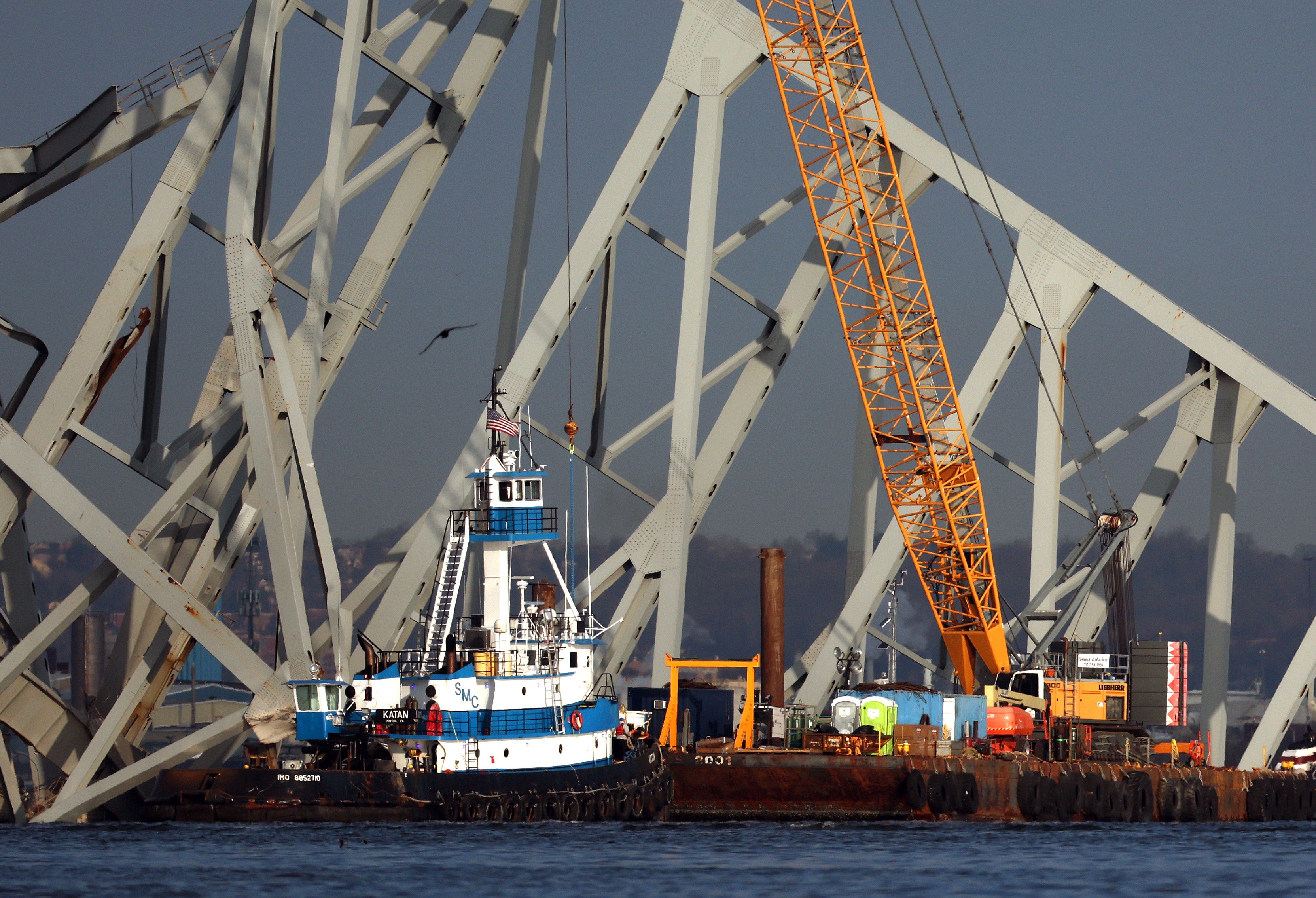Enormous cranes have started to arrive in Baltimore to help clear the wreckage after the collapse of the Francis Scott Key Bridge — an essential step before recovery efforts to find the missing construction workers continue, officials say.
A massive cleanup operation is now underway to clear the wreckage of the bridge from the river, with huge crane ships, and thousands of relief workers headed for Baltimore.
One of the cranes, the Chesapeake 1000, is capable of lifting 1,000 tonnes — but the bridge is estimated to weigh around three or four times that, so it will need to be cut into sections, Maryland governor Wes Moore said.
Mr Moore surveyed the scene and saw shipping containers ripped apart “like papier-mache.”
To understand the scale the teams are working with, the governor said that the freight was roughly the size of the Eiffel Tower.
“The best minds in the world” are working on the plans for removal, Mr Moore said.
Meanwhile, US president Joe Biden said on Friday he will go to Baltimore next week.
He also announced he has approved $60m in initial aid to rebuild the bridge.
Fundraisers garner $200k for families of victims
One GoFundMe page raised over $98,000 in just nine hours.
The fundraiser, organised by the volunteer group Latino Racial Justice Circle, explained that the cash would be “distributed directly” to the “families of the victims” of the bridge collapse.
Eight construction workers, employed by Brawners Builders, were filling potholes in the early hours of 26 March, when the Dali container ship lost power and rammed into the bridge, causing them to fall into the Patapsco River.
While early search efforts led to the safe rescue of two men, six others were killed in the accident.
All of the missing men from Mexico, El Salvador, Guatemala and Honduras, Col Roland Butler Jr of Maryland State Police said at a press conference.
The organisers of the fundraiser wrote, “We know that the 6 victims were all Latino immigrants,” some of whom “were supporting partners and children in the Southeast Baltimore and Dundalk communities.”
“As they move forward with their shock and grief, the families will need support with basic needs, such as rent, groceries, and utilities,” they wrote.
Read the full story...
Baltimore Key Bridge worker reveals last-minute shift change saved his life
A construction worker from Baltimore has revealed how he narrowly escaped the deadly Baltimore bridge collapse thanks to a last-minute change in his work shift.
Moises Diaz, a 45-year-old worker at Brawny Builders, told the New York Post that he should have been working on the Francis Scott Key Bridge on Tuesday morning but asked to switch his shift.
“If I didn’t ask to switch, I would have been in the water right now,” Mr Diaz said through a translator.
“It’s tragic,” Mr Diaz continued. “I’m really appreciative that I wasn’t on the bridge. I give thanks to God.”
Mr Diaz’s colleagues weren’t so lucky.
Amelia Neath has the full story...
Clearing the debris could take a while, expert says
Officials announced that the search efforts have concluded and they have now moved into the clean-up process.
“This is daunting. This is complicated,” Maryland Gov Wes Moore said about the start of the process. He did not provide a timeline for how long it would take, but warned: Our timeline will be long...People should rest assured we are going to get this done.”
The process could take “a few weeks,” James Bell, president of Chicago-based company ADCO Environmental Services, told the Washington Post.
“The hazmat crew always goes in after the emergency responders,” Mr Bell said.
“You have to remove the hazards, so that when you bring your new workers in to start removing the bridge, they’re not in harm’s way.”
ICYMI: The timeline of the events before the crash
Federal investigators from the National Transportation Safety Board (NTSB) have unveiled a more precise timeline of exactly what happened in the runup to the cargo ship’s brutal collision with the Francis Scott Key Bridge in the early hours of Tuesday morning.
Here’s the NTSB’s revised timeline of the disaster, given in hours, minutes and seconds after experts’ first full day examining the scene on Wednesday:
12.39am: Dali container ship departs from Seagirt Marine Terminal.
1.07am: It enters Fort McHenry Channel.
1.24.59am: Numerous audible alarms recorded on ship’s bridge audio. Voyage data recorder (VDR) stops recording the vessel’s system data, although it is able to continue taping audio from alternative power source.
1.26.02am: VDR resumes recording ship’s system data after glitch. Steering commands and orders regarding its rudder captured on audio.
1.26.39am: Pilot issues very high frequency (VHF) radio call to nearby tugboats requesting assistance for the stricken vessel. Pilot association dispatcher also notifies Maryland Transportation Authority (MDTA) duty officer regarding blackout, according to data from latter organisation.
1.27.04am: Pilot orders ship’s port anchor to be dropped and issues additional steering commands.
1.27.25am: Pilot issues radio call over VHF radio, reports that vessel has lost all power and is approaching bridge. Transit authority duty officer radios two of its units — one on each side of bridge — that are already on scene and orders them to close traffic. All lanes shut down.
1.29am: Ship’s speed recorded at just under 8 miles per hour. VDR records 33 seconds of sound consistent with vessel’s smash with bridge. MDTA dash cameras meanwhile capture bridge lights going out.
01.29.39am: Pilot radios US Coast Guard to report bridge is down.
In photos: the scene of the collapse


Watch: Massive crane arrives to haul wreckage
The largest crane on the US eastern seaboard has been called in to help clear the wreckage of Baltimore’s collapsed Francis Scott Key Bridge.
Shipments in and out of one of America’s busiest ports are suspended while the wreckage hangs over the cargo ship that crashed into it.
Crews were still surveying the damage as of midday on Friday 29 March and a search for the bodies of four workers remains on hold because of the dangers of diving amongst the wreckage.
The crane, which can lift up to 1,000 tons, arrived late Thursday night and is expected to start hauling debris out of the water on Saturday morning.
A cargo ship crashed into the Key Bridge early on Tuesday, sending the structure tumbling into the Patapsco River.
Watch here:

Largest crane on eastern seaboard in place to clear wreckage of Baltimore bridge
The largest crane on the US eastern seaboard has been called in to help clear the wreckage of Baltimore’s collapsed Francis Scott Key Bridge. Shipments in and out of one of America’s busiest ports are suspended while the wreckage hangs over the cargo ship that crashed into it. Crews were still surveying the damage as of midday on Friday 29 March and a search for the bodies of four workers remains on hold because of the dangers of diving amongst the wreckage. The crane, which can lift up to 1,000 tons, arrived late Thursday night and is expected to start hauling debris out of the water on Saturday morning. A cargo ship crashed into the Key Bridge early on Tuesday, sending the structure tumbling into the Patapsco River.
Construction worker ‘miraculously’ survives Baltimore bridge collapse without knowing how to swim
A construction worker who was part of the team on the Francis Scott Key Bridge when it collapsed early on Tuesday morning in Baltimore, miraculously survived the incident despite not knowing how to swim.
Julio Cervantes’ and seven other workers from Mexico and Central America were taking a break inside their cars just moments before the bridge collapsed around 1:30am.
Mr Cervantes and another man were rescued the same day. The remains of Alejandro Hernandez Fuentes, 35, and Dorlian Ronial Castillo Cabrera, 26, were recovered by searchers.
He was taken to the hospital with a chest wound and was released the same day
“My husband doesn’t know how to swim. It is a miracle he survived,” the wife of Cervantes, who did not wish to reveal her name, told NBC.
ICYMI: Four bodies remain unaccounted for
Four bodies are still missing after the Francis Scott Key Bridge collapsed on Tuesday morning.
Divers found the two victims trapped in a red pickup truck a little before 10 am on Wednesday in about 25 feet of water around the bridge’s middle span.
They were identified as construction workers Alejandro Hernandez Fuentes, 35, of Baltimore and Dorlian Ronial Castillo Cabrera, 26, of Dundalk, Maryland.
Meanwhile, four other missing construction workers remain unaccounted for.
On Tuesday, officials said two people had been rescued alive from the water. One was uninjured while the other was in a serious condition.
Trump criticised for staying silent on Baltimore bridge collapse
Since Tuesday night when a cargo ship slammed into the Francis Scott Key Bridge, killing six people, all immigrants, Mr Trump has only posted one clip of Sean Hannity criticising President Joe Biden for making only a brief remark and "making it all about himself by mentioning his personal connection".
Mr Trump, who is usually known for his consistent and repeated posts on social media on any topic in the national news, is being criticised for remaining largely silent.
Republican strategist Scott Reed said this silence from Mr Trump is "a little weird," journalist Mike Sington shared on Twitter.
"It was a national tragedy, it’s going to cost $2 billion, it’s going to screw up a lot of people’s lives and impact goods travelling around the world," Mr Reed said, according to Mr Sington's post on X.
"At a minimum, express sympathy toward the poor six men that died that were doing their jobs on the midnight shift, keeping commerce flowing.”
Transport secretary responds to 'wild conspiracy theories' over Baltimore bridge collapse
Transport secretary Pete Buttigieg said the "misinformation or disinformation" spreading on social media following the deadly Baltimore bridge collapse has been "upsetting" for his department.
Speaking with Kaitlan Collins on CNN, the transport secretary said his department was not in the habit of dealing with rampant conspiracies or "that kind of wild thinking".
"But unfortunately, it is a fact of life in America today," he said.
"What's really upsetting of course is that when misinformation or disinformation circulates that is not without victims."
Speculations about how the bridge collapsed and what happened in the final hours have ranged from cyber attacks to the captain of the ship having side-effects from Covid vaccine, Ms Collins said.
Mr Buttigieg said what his department needs right now is "good and factual information".
"We as a department need good factual information about how this happened so that we can include that in future decisions on everything from maritime and shipping policy to bridge design for the 2030 2040," he told CNN.
"All of that requires being grounded in fact and that's what we're doing," he said, adding that he respects independent work.
https://news.google.com/rss/articles/CBMicmh0dHBzOi8vd3d3LmluZGVwZW5kZW50LmNvLnVrL25ld3Mvd29ybGQvYW1lcmljYXMvYmFsdGltb3JlLWtleS1icmlkZ2UtY29sbGFwc2UtZGVhdGhzLWNyYW5lLXVwZGF0ZXMtYjI1MjA5NjIuaHRtbNIBAA?oc=5
2024-03-30 10:48:18Z
CBMicmh0dHBzOi8vd3d3LmluZGVwZW5kZW50LmNvLnVrL25ld3Mvd29ybGQvYW1lcmljYXMvYmFsdGltb3JlLWtleS1icmlkZ2UtY29sbGFwc2UtZGVhdGhzLWNyYW5lLXVwZGF0ZXMtYjI1MjA5NjIuaHRtbNIBAA

Tidak ada komentar:
Posting Komentar